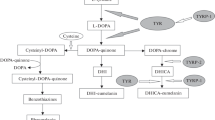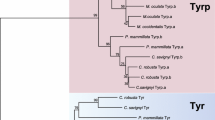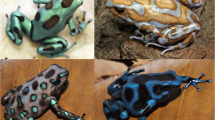Summary
-
1.
The genetics of some colour breeds was investigated. One gene is responsible for the degree of pigmentation of the melanophores (normal pigmentation versus slight pigmentation); another one controls the arrangement of the pigment cells (longitudinal stripes-spot pattern respectively); and a third one regulates the destruction of all the xanthophores and some of the iridophores and melanophores.
-
2.
The melanophores of the longitudinal stripes and those of the spots lie in the uppermost subcutaneous layer. More melanophores were found in the epidermis above and below the scales; with others making direct contact with the scales or occurring in the loose dermis within the scale pockets.
-
3.
The ontogenetic sequence of pattern formation in the phenotypesre, fr andgr was investigated.
-
4.
The reduced pigmentation of melanophores of the light formmlr could not be explained by a lack of chromogen (Dopa) but was found to be based upon the intrinsic formation of numerous intermediary weakly pigmented “melanosome” within these cells.
-
5.
A phenocopy of themlr type could be obtained by treatment with phenylthiourea (0.002–0.004%).
-
6.
Factors within the subcutis were proved responsible for the formation of the melanophore stripes. The stability of these factors was demonstrated by auto- and isotransplantation.
-
7.
Melanoblasts could be found in the xanthophore stripes of the anal fin of the wild form.
-
8.
The number of xanthophores in the anal fin of the phenotypesre andmlr is nearly twice as high as that of the phenotypefr. ♂♂ and ♀♀ always show the same number of xanthophores.
-
9.
In the xanthophores offr-animals melanosome-like structures were found which do not occur in there-phenotypes.
Zusammenfassung
-
1.
Kreuzungsexperimente mit Farbmusterrassen ergaben, daβ das Farbmuster von mindestens 3 Genen kontrolliert wird. Eines regelt die Anordnung der Pigmentzellen (Streifen- bzw. Tüpfelmuster), ein anderes den Grad der Melanophorenpigmentierung (normal pigmentiert—schwach pigmentiert) und ein drittes ist verantwortlich für das überleben eines Teils der Pigmentzellpopulation (vor allem der Xanthophoren).
-
2.
Die Melanophoren des Längsstreifen- bzw. Tüpfelmusters liegen in der obersten Subcutis-Schicht. Auβerdem finden sich Melanophoren in der Epidermis oberhalb und unterhalb der Schuppen; weitere liegen den Schuppen direkt an, während andere in der lockeren Cutis im Bereich der Schuppentaschen zu finden sind.
-
3.
Der ontogenetische Ablauf der Musterbildung bei den Phänotypenre undfr wurde untersucht. Die embryonalen Melanophorenmuster vonre undfr sind identisch. Beire entstehen daraufhin auf den Flanken Melanophorenstreifen, zunächst dorso-lateral und später auch im ventro-lateralen Bereich. Die Formfr bildet zunächst viele Melanophoren aus, die sich gleichmäβig über die Flanken verteilen. Bei 40–50 Tage alten Tieren rücken die Melanophoren dann zu Gruppen von etwa 3-9 Zellen (Tüpfel) zusammen. Im Alter von 50 Tagen sind somit die endgültigen Muster vonre undfr angelegt. Bei beiden Formen besteht anscheinend keine Beziehung zwischen der Ausbildung des embryonalen und der des adulten Melanophorenmusters.
Beim Phänotypgr läuft die Musterbildung in der späten Ontogenese ab. Das zunächst normale Längsstreifenmuster wird frühestens im Alter von 8 Monaten durch Zerstörung aller Xanthophoren und einiger der Iridophoren und Melanophoren abgewandelt.
-
4.
Die verminderte Pigmentierung der Melanophoren der hellen Formmlr beruht auf der Ausbildung von zahlreichen intermediären, kaum pigmentierten “Melanosomen”. Sie läβt sich nicht mit einem Mangel an Chromogen erklären.
-
5.
Eine Kopie desmlr-Phänotyps—beire-Tieren—ist mit Hilfe von Phenylthioharnstoff (0,002–0,004%) möglich. Die Hemmung der Melanogenese hat dabei keinen Einfluβ auf die Entstehung des embryonalen Melanophorenmusters.
-
6.
In der Subcutis lassen sich Faktoren nachweisen, die für die Entstehung des Streifenmusters verantwortlich sind. Die Stabilität dieser Faktoren wird durch Auto- und Isotransplantationen belegt.
-
7.
In den Xanthophorenstreifen der Analflosse des Wildtyps konnten Melanoblasten nachgewiesen werden.
-
8.
Die Zahl der Xanthophoren in der Analflosse bei den Phänotypenre undmlr ist fast doppelt so hoch wie beifr (♂♂ und ♀♀ zeigen stets die gleiche Anzahl von Xanthophoren).
-
9.
In den Xanthophoren vonfr finden sich melanosomenähnliche Strukturen; beire fehlen diese.
Similar content being viewed by others
Literatur
Anders, F., Klinke, K., Vielkind, U.: Genregulation und Differenzierung im Melanom-System der Zahnkärpflinge. Biol. in uns. Zeit2, 35–45 (1972)
Andres, G. M.: Eine experimentelle Analyse der Entwicklung der larvalen Pigmentmuster von fünf Anurenarten. Zoologica40 (H. 111), 1–112 (1963)
Bagnara, J. T.: Interrelationship of melanophores, iridophores and xanthophores. J. invest. Derm.54, 82–83 (1970, Abstracs of the VII international pigment cell conference)
Bagnara, J. T., Taylor, J. D.: Differences in pigment-containing organelles between color forms of the red-backed salamander, Plethodon cinereus. Z. Zellforsch.106,412–417 (1970)
Becker, C.: Untersuchungen zur Phänogenese von Melanophorenmustern bei Zahnkarpfen. Z. wiss. Zool.172, 37–104 (1965)
Dalton, H. C.: Inhibition of chromatoblast migration as a factor in the development of genetic differences in pigmentation in white and black axolotls. J. exp. Zool.115, 151–173 (1950a)
Dalton, H. C.: Comparison of white and black axolotl chromatophores in vitro. J. exp. Zool.115, 17–35 (1950b)
Finnegan, C. V.: Ventral tissues and pigment pattern in salamander larvae. J. exp. Zool.128, 453–479 (1955)
Goodrich, H. B.: One step in the development of hereditary pigmentation in the fish Oryzias latipes. Biol. Bull.65, 249–252 (1933)
Goodrich, H. B.: Problems of origin and migration of pigment cells in fish. Zoologica35, 17–19 (1950)
Goodrich, H. B., Greene, J. M.: An experimental analysis of the development of a color pattern in the fish Brachydanio albolineatus Blyth. J. exp. Zool.141, 15–46 (1959)
Goodrich, H. B., Hine, R. L., Reynolds, J.: Studies of the terminal phases of color pattern formation in certain coral reef fish. J. exp. Zool.114, 603–625 (1950)
Goodrich, H. B., Marzullo, C. M., Bronson, W. R.: An analysis of the formation of color pattern in two fresh-water fish. J. exp. Zool.125, 487–506 (1954)
Goodrich, H. B., Nichols, R.: The development and the regeneration of the color pattern in Brachydanio rerio. J. Morph.52, 513–523 (1931)
Hildemann, W. H.: Early onset of the homograft reaction. Transplant. Bull.3, 144–145 (1956)
Hildemann, W. H.: Scale Transplantation in goldfish (Carassius auratus). Ann. N. Y. Acad. Sci.64, 775–791 (1957)
Hildemann, W. H.: Tissue transplantation immunity in goldfish. Immunology1, 46–53 (1958)
Hildemann, W. H., Cooper, E. L.: Immunogenesis of homograft reactions in fishes and amphibians. Fed. Proc.22, 1145–1151 (1963)
Hildemann, W. H., Haas, R.: Comparative studies of homotransplantation of fishes. J. cell. comp. Physiol.55, 227–233 (1960)
Hildemann, W. H., Owen, R. D.: Histocompatibility genetics of scale transplantation. Trans-plant. Bull.4, 132–134 (1956)
Hisaoka, K. K., Battle, H. J.: The normal developmental stages of the zebra fish, Brachydanio rerio. J. Morph.102, 311–328 (1958)
Holtfreter, J.: Gewebeaffinität, ein Mittel der embryonalen Formbildung. Arch. exp. Zellforsch.23, 169–209 (1939)
Kallman, K. D.: Transplantation of fins in xiphophorin fishes. Ann. N.Y. Acad. Sci.71 (7), 307–318 (1957)
Kallman, K. D.: An estimate of the number of histocompatibility loci in the teleost Xiphophorus maculatus. Genetics50, 583–595 (1964)
Kallman, K. D.: Genetics of tissue transplantation in teleostei. Transplant. Proc.2, 263–271 (1970)
Kallman K. D., Gordon, M.: Genetics of fin transplantation in xiphophorin fishes. Ann. N.Y. Acad. Sci.73, 599–610 (1958)
Laidlaw, G. F.: The dopa reaction in normal histology. Anat. Rec.53, 399–413 (1932)
Lehman H. E.: The suppression of melanophore differentiation in salamander larvae following orthotopic exchanges of neural folds between species of Amblystoma and Triturus. J. exp. Zool.114, 435–463 (1950)
Lehman, H. E.: The developmental mechanics of pigment pattern formation in the black axolotl, Amblystoma mexicanum. I. The formation of yellow and black bars in young larvae. J. exp. Zool.135, 355–386 (1957)
Lehman, H. E., Youngs, L. M.: Extrinsic and intrinsic factors influencing amphibian pigment pattern formation. In: Pigment cell biology (M. Gordon, ed.), p. 1–36. New York: Academic Press 1959
Markert, C. D., Silvers, W. K.: Effects of genotyp and cellular environment of melanocyte morphology. In: Pigment cell biology (M. Gordon, ed.), p. 241–248 New York: Academic Press 1959
Nardi, F.: Das Verhalten der Schuppen erwachsener Fische bei Regenerations-und Trans-plantationsversuchen. Wilhelm Roux' Arch. Entwickl.-Mech. Org.133, 621–663 (1935)
Nickerson, M.: An experimental analysis of barred pattern formation in feathers. J. exp. Zool.95, 361–397 (1944)
Petrovicky, I.: Kreuzungen der Arten Brachydanio rerio und Brachydanio frankei (in tschechischer Sprache). Ak varium a teŕarium7, 66–69 (1964)
Rawles, M. E.: Origin of melanophores and their role in development of colar patterns in vertebrates. Physiol. Rev.28, 383–408 (1948)
Stevens jr., L. C.: The origin and development of chromatophores of Xenopus laevis and other anurans. J. exp. Zool.125, 222–246 (1954)
Taylor J. D.: The presence of reflecting platelets in integumental melanophores of the frog, Hyla arenicolor. J. Ultrastruct. Res.35, 532–540 (1971)
Thumann, M. E.: Die embryonale Entwicklung des Melanophorensystems bei Brachydanio rerio (Hamilton-Buchanan). Z. mikr.-anat. Forsch.25, 50–96 (1931)
Trinkaus, J. P.: Estrogen, thyroid hormone, and the differentiation of pigment cells in the Brown Leghorn. In: Pigment cell growth (M. Gordon, ed.), p. 73–90. New York: Academic Press 1953
Twitty, V. C.: Correlated genetic and embryological experiments on Triturus I. and II. J. exp. Zool.74, 239–302 (1936)
Twitty, V. C.: Chromatophore migration as a response to mutual influences of the developing pigment cells. J. exp. Zool.95, 259–290 (1944)
Twitty, V. C.: The developmental analysis of specific pigment patterns. J. exp. Zool.100, 141–178 (1945)
Twitty, V. C.: Developmental analysis of amphibian pigmentation. Growth (Suppl.)9, 133–161 (1949)
Twitty, V. C.: Intercellular relations in the development of amphibian pigmentation. J. Embr. exp. Morph.1, 263–268 (1953)
Twitty, V. C., Bodenstein, D.: Correlated genetic and embryological experiments on Triturus. III. and IV. J. exp. Zool.81, 357–398 (1939)
Twitty, V. C.: The motivation of cell migration, studied by isolation of embryonic pigment cells singly and in small groups in vitro. J. exp. Zool.125, 451–473 (1954)
Twitty, V. C., Niu, M. C.: Causal analysis of chromatophore migration. J. exp. Zool.108, 405–438 (1943)
Willier, B. H., Rawles, M. E.: The control of feather color pattern by melanophores grafted from one embryo to another of a different breed of fowl. Physiol. Zool.13, 177–199 (1940)
Willier, B. H.: Specializations in the response of pigment cells to sex hormones as exemplified in the fowl. Arch. Anat.39, 451–466 (1951)
Author information
Authors and Affiliations
Additional information
Herrn Professor Dr. A. Egelhaaf gilt mein besonderer Dank für die Anregung zu dieser Arbeit und für seine Unterstützung im Verlauf der Untersuchungen.
Herrn Professor Dr. Andres danke ich für die sehr kritische Durchsicht des Manuskriptes.
Rights and permissions
About this article
Cite this article
Kirschbaum, F. Untersuchungen über das Farbmuster der ZebrabarbeBrachydanio rerio (Cyprinidae, Teleostei). Wilhelm Roux' Archiv 177, 129–152 (1975). https://doi.org/10.1007/BF00848526
Received:
Issue Date:
DOI: https://doi.org/10.1007/BF00848526




